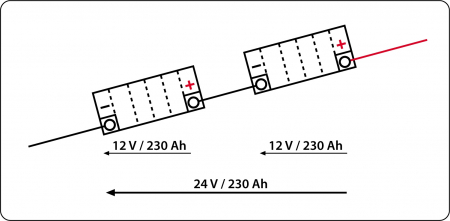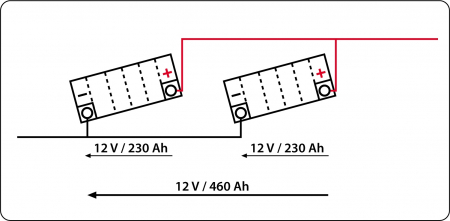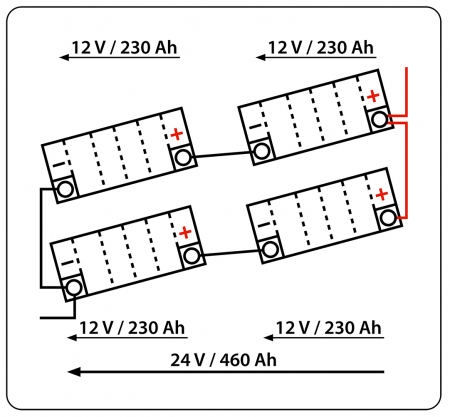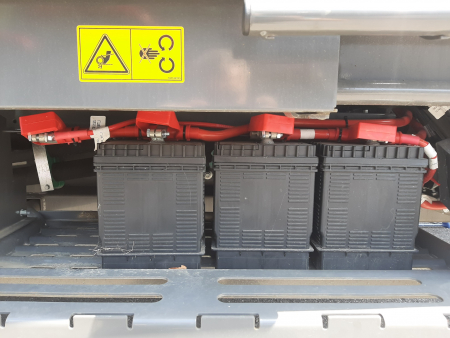SERIES AND PARALLEL CIRCUITS
THIS IS THE DIFFERENCE
Interconnections between batteries have an effect on voltage or capacity and performance during a cold start.

Series circuit
Added voltages
For a series circuit the voltages of the individual batteries are added together. Two 12 V batteries must be connected in series in order to implement a 24 V electrical system power supply.
Please note:
- Both batteries must have the same type designation.
- Both batteries must be around the same age.
- Both batteries must have the same state of charge.
- The connecting cables must be of the right size and be kept as short as possible.
- Always change both batteries.
If the above recommendations are not complied with, the voltage will be distributed accordingly if the batteries are in series due to their different internal resistances, resulting in an asymmetrical load during the charging and discharging phases.
If asymmetry (= imbalance) cannot be avoided (due to different temperatures of the batteries or 12 V partial loads), we recommend that you use the Charging Equalizer. This adjusts the charging voltage across the batteries so that they are even.
Please note: When checking the charging voltage in the vehicle, you must also check the individual voltage of each battery.

Parallel circuits
Added capacities and cold start currents
For a parallel circuit the capacities and cold start currents of the individual batteries.
Please note:
- Both batteries must have the same type designation.
- Both batteries must be around the same age.
- Both batteries must have the same state of charge.
- The connecting cables must be of the right size and be kept as short as possible.
- Always change both batteries.
If the above recommendations are not adhered to, the different internal resistances of each battery will result in a corresponding division of the current and thus an asymmetrical (= unbalanced) load during the charging and discharging phases.
In parallel circuits, sometimes high compensation currents flow between the batteries. If possible, we recommend that you use just one higher-capacity battery.

Series and parallel connection combined!
What happens exactly?
Series connection - added voltages
In series connection (= series circuit), the voltages of the individual batteries add up. To be able to realise a 24V on-board power supply, two batteries with 12V must be connected in series.
Parallel connection - added capacities and cold start currents
With parallel connection, the capacities and the cold start currents of the individual batteries add up.
Please note:
- All batteries must have the same type designation.
- All batteries must be approximately the same age.
- All batteries must have the same state of charge.
- The connecting cables must be sufficiently dimensioned and should be kept as short as possible.
- Always replace all batteries!

A brief practical example
AGCO Fendt IDEAL combine harvester, series 7, 8, 9 and 10
With 12 V on-board power supply and a total of 4 built-in batteries* for engine starting and on-board power supply.
Two batteries are connected in series by a changeover relay just for starting the engine, resulting in a 24 V starter voltage.
2 x 12 V = 24 V
The remaining combine harvester runs completely on 12 V and also gets them at the starting process. All 4 batteries are thus always connected in parallel, for example for the 12 V operation of all additional units such as the electric rape cutter and many more.
4 x 105 Ah = 420 Ah capacity (K20) and 4 x 1,000 A = 4,000 A (EN) cold start
*OEM batteries with 95 Ah (K20), 900 A (EN) in US BCI 31 housing and centre terminal 9
= Banner Buffalo Bull Type 605 02 with 105 Ah (K20) and 1,000 A (EN)
PS: Info on the picture - the fourth battery on the far left was removed shortly before the photo shoot.
Why always replace both or all batteries?
With increasing use of the batteries, the internal resistance changes. The older the battery, the higher the internal resistance. If an “old” battery is now connected to a “new” battery , currents or voltages are distributed differently and asymmetrical (= unbalanced) loads occur
If the batteries are not charged or discharged, then very high compensation currents flow between the batteries in a parallel circuit. This means that the “new” battery tries to charge the “old” battery. (potential equalisation)
You might also be interested in the following

